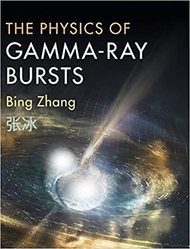Bing Zhang
Education
BS, Geophysics, Beijing University, 1991 PhD, Astrophysics, Beijing University, 1997
Research Interests

Bing Zhang's primary research interest is high-energy astrophysics, which studies, among other things, black holes of various scales, neutron stars of various species, and the intense "jets" they launch. For many years, Zhang has been studying the physical mechanisms of Gamma-ray bursts (GRBs), the most luminous explosions in the universe. He published a book titled "The Physics of Gamma-Ray Bursts" with the Cambridge University Press in 2018. Recently, Zhang is actively working on two emerging fields: multi-messenger (gravitational waves and electromagnetic counterparts, high energy neutrinos) astrophysics and a type of mysterious bursts known as fast radio bursts (FRBs).
Gamma Ray Bursts

Bing Zhang is known for his theoretical work on several subjects in the field of GRBs: e.g., a canonical afterglow lightcurve and interpretation, a prompt emission model invoking internal collision-induced magnetic reconnection and turbulence (ICMART), a magnetar central engine, a quasi-universal structured jet, a physical classification scheme, among others. His work has been found useful in interpreting the rapidly growing body of GRB data, and several of his predictions have been verified by observations. As a science team member of NASA's Neil Gehrels Swift Observatory, he has contributed to theoretical interpretations of several major discoveries published in the journals Nature or Science, including the discoveries of the first short GRB afterglow, early afterglow features such as X-ray flares and steep decay, first low-luminosity GRB with an X-ray shock-breakout signature, the "naked-eye" GRB, the first jetted tidal disruption event, etc.
Fast Radio Bursts

Bing Zhang is recently keen on understanding the nature of FRBs. He and his students have proposed physically motivated FRB source and emission models for both repeating and non-repeating FRBs and are among the earliest to propose a few ways of probing the universe using FRBs. With his international collaborators, Zhang recently used of China's Five-hundred-meter Aperture Spherical Telescope (FAST) and made several discoveries published in Nature of Science, including varying polarization angle of a repeating FRB source that supports a magnetospheric origin of FRBs, non-detection of radio pulse emission during many X-ray bursts of a Galacic magnetar, thousands of bursts from two active repeating FRB sources, a new repeating source with persistent radio emission and a large source dispersion measure, and evidence of multi-path origin of rotation measure scatter of a sample of repeating sources. He also published a review article titled "The physical mechanisms of fast radio bursts" in Nature.
Electromagnetic Counterparts of Gravitational Waves
Bing Zhang has worked on theoreical modeling of various types of EM counterparts of GWs. For many years, he has advocated a supramassive neutron star as the merger product of at least some NS-NS mergers, as evidenced by the existence of the so-called "internal plateaus" in a good fraction of short GRBs. He systematically studied various components that contribute to the delay time between GW chirp and the associated GRB. For the kilonova counterpart, he and collaborators were among the earliest to propose that energy injection from a post-merger magnetar would modify the kilonova signature. He also proposed several novel EM counterparts of GWs hitherto not confirmed, including short GRB X-ray plateau emission powered by a post-merger magnetar (such an EM signal was indeed discovered, e.g. CDFS XT2 and a few others), an FRB following a NS-NS merger when the supermassive NS collapses, as well as a brief FRB-like EM signal associated with charged compact binary coalescences (especially plunging BH-NS mergers). With collaborators, he also suggested that low-frequency GWs due to massive BH mergers would be damped and not be detectable unless the intergalatic magnetic field strength is very low.
 Department of
Department of